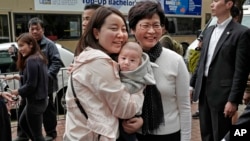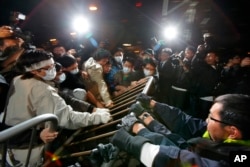A big challenge facing Hong Kong’s newly elected chief executive, Carrie Lam, is a controversial $11 billion high-speed rail line and station that links the port city with China.
Critics have called the project a political time bomb and warned of the fiscal challenges the project could bring.
What’s more, Beijing plans to install Chinese police at the station, which has some worried that it could be the first test of how Lam will strike a balance between the interests of Beijing and Hong Kong’s citizens.
Watch: China High-Speed Rail Could be New Hong Kong Leader's First Big Test
The Lam way?
Days after being voted into her new job, Lam paid courtesy calls to Beijing’s liaison office and the People’s Liberation Army garrison in Hong Kong and announced that Beijing’s representative branches would let her run things her way.
But her words may be put to the test right after she takes office July 1, when her administration gears up to finalize details of the new express rail, which is scheduled to begin operation in the third quarter of next year.
A promotional video from Hong Kong’s MTR Corp. has presented a sleek modern picture of the express rail and what the West Kowloon Terminus will look like when the 26-kilometer-long section in Hong Kong is finished.
State-of-the-art bullet trains traveling through underwater tunnels at a maximum speed of 200 kilometers per hour will transport an estimated 3 million passengers between Hong Kong and Guangzhou each month.
The trip’s travel time will be cut by half to less than an hour.
And from Guangzhou, the rail line will connect with China’s 16,000-kilometer-long express rail network, the largest in the world, to arrive at major Chinese cities within hours.
Further integration
For Beijing, the project highlights its vision to make travel to China more efficient and to enhance social, economic and cultural integration with the port city.
But for some Hong Kong residents, the project is a nightmare.
“[There] will be more Chinese people to come to Hong Kong more easily, and we don’t like that,” Carol Chow, a Hong Kong housewife and mother told VOA.
Chow said she and many others are also worried about the impact the project could have on the city’s pricey real estate and goods.
And pervasive Chinese influence in the city has further jeopardized the Hong Kong citizens’ way of life, she added.
Simmering anti-China resentment
Resentment against visitors from China has been simmering for years in Hong Kong, and with the project boosting the number who are likely to come here, it could fuel tensions further.
In 2015, for example, ahead of the Chinese New Year holiday, hundreds Hong Kong residents flooded the city’s shopping districts to protest what was perceived as the advantage taken by mainland visitors of the city’s lower priced staple goods.
The demonstrators taunted Chinese shoppers with the derogatory Cantonese slur “wong chung,” or “locusts,” which turned into the city’s most combative protests since the Occupy movement in 2014.
The protesters said they were angry that Chinese shoppers had clogged the city’s transit system and emptied stores of basic necessities like powdered baby formula.
Local officials, nevertheless, have never tried to slow the territory’s further integration with the mainland.
Hong Kong has reportedly agreed to let China deploy police inside the terminus, a decision that is raising questions about whose laws will be enforced and whether there will be a violation of the “one country, two systems” model, under which Hong Kong is supposed to maintain its legal autonomy.
Some younger residents see this project as another effort for China to exert control over the port city, disguised as a business-friendly infrastructure project.
“As time goes by, if China continues to set up more of these freedom-controlling policies, I think that is getting more and more unacceptable,” a 16-year-old college student, surnamed Lee, told VOA.
Integrated checkpoint
Discussions about checkpoint arrangements at the station were held recently between Hong Kong and Chinese authorities, but no details have been released.
Observers say local authorities are holding off over concerns of a public backlash.
Expressing opposition to such an integrated checkpoint, Albert Lai, policy convener of The Professional Commons, argued that having mainland police on the Hong Kong soil could jeopardize Hong Kong citizens’ civic rights. He said the city has witnessed the apparent abduction of booksellers and a Chinese businessman.
Political debts
He also doubts Lam will be able to say no to Beijing, which supported her election.
“She has to repay debts, the political debts, to cater [to] the vested interests and to cater [to] Beijing’s demands. So, it’s very hard to see that she can have the political clout to stand for the interests of Hong Kong people even if she wants to do so,” Lai told VOA.
The city’s business community has largely welcomed the railway project. For them, speedy customs clearance is more important than the controversial integrated checkpoint.












